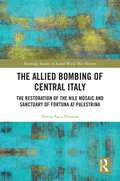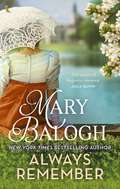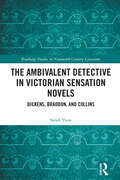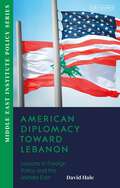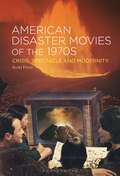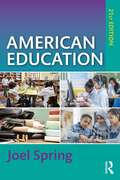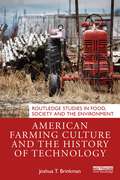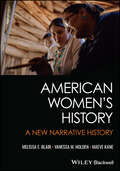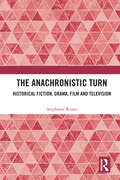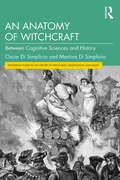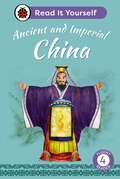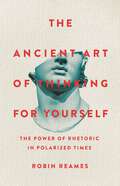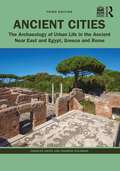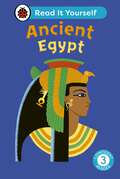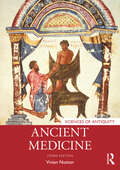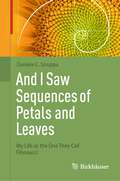- Table View
- List View
The Allied Bombing of Central Italy: The Restoration of the Nile Mosaic and Sanctuary of Fortuna at Palestrina (Routledge Studies in Second World War History)
by Teresa Fava ThomasThe Allied Bombing of Central Italy examines the results of the Second World War Allied bombing campaign on Palestrina and Rome, Italy, and the long-term impact of the war on the mountainside town and on the Barberini family's art collection including the Nile Mosaic. It explores the history and cultural significance of Palestrina, its strategic setting, the recovery of the town, the restoration of the Nile Mosaic, which remains the largest Egyptian-style mosaic extant. A unique aspect of the destruction was that it uncovered a pagan temple, the Sanctuary of Fortuna. The bombing destroyed the homes built on its terraces but revealed the ancient structure buried beneath which had remained unseen for half a millennium. It took more than a decade for the mosaic to be restored and the Sanctuary of Fortuna established as a national archeological museum. The book explores the pressure by the Mussolini regime to control the Barberini family's art collection, the uses of cultural materials for propaganda purposes, the Allied use of airpower in the Italian theater of war, the postwar decision-making and recovery process. The book is one of the very few long-range studies of the war's impact on a single Italian town. It is suitable for academic seminars and an educated general audience.
The Allied Bombing of Central Italy: The Restoration of the Nile Mosaic and Sanctuary of Fortuna at Palestrina (Routledge Studies in Second World War History)
by Teresa Fava ThomasThe Allied Bombing of Central Italy examines the results of the Second World War Allied bombing campaign on Palestrina and Rome, Italy, and the long-term impact of the war on the mountainside town and on the Barberini family's art collection including the Nile Mosaic. It explores the history and cultural significance of Palestrina, its strategic setting, the recovery of the town, the restoration of the Nile Mosaic, which remains the largest Egyptian-style mosaic extant. A unique aspect of the destruction was that it uncovered a pagan temple, the Sanctuary of Fortuna. The bombing destroyed the homes built on its terraces but revealed the ancient structure buried beneath which had remained unseen for half a millennium. It took more than a decade for the mosaic to be restored and the Sanctuary of Fortuna established as a national archeological museum. The book explores the pressure by the Mussolini regime to control the Barberini family's art collection, the uses of cultural materials for propaganda purposes, the Allied use of airpower in the Italian theater of war, the postwar decision-making and recovery process. The book is one of the very few long-range studies of the war's impact on a single Italian town. It is suitable for academic seminars and an educated general audience.
Always Remember: Fall in love against the odds in this charming Regency romance (Ravenswood)
by Mary BaloghLady Jennifer Arden and Ben Ellis know that a match between them is out of the question. Yet their hearts yearn for the impossible. Discover a new heartwarming story from New York Times bestselling author and beloved 'queen of Regency romance' Mary Balogh.A match between them is out of the question . . .Left unable to walk by a childhood illness, Lady Jennifer, sister of the Duke of Wilby, has made a happy place for herself in society - even if she cannot dance at balls or stroll in Hyde Park. She is blessed with a loving, protective family, but secretly dreams of marriage, children, walking - and dancing.When Ben Ellis comes across Lady Jennifer as she struggles to walk with the aid of primitive crutches, he understands her yearning. He never saw a practical problem he did not have to solve, and he wants to help her discover her independence. But as the illegitimate son of the late Earl of Stratton he must be careful, for although raised with the earl's family, he knows he does not really belong in the world of the ton.Jennifer is shocked - and intrigued - by Ben's ideas, and both families are alarmed by the growing friendship and perhaps more that they sense developing. A duke's sister certainly cannot marry the illegitimate son of an earl. Except sometimes, love can find a way.Don't miss the first two Ravenswood novels, Remember Love and Remember Me - out now!Praise for Mary Balogh:'A grand mistress of the genre' Romantic Times'Balogh is the queen of spicy Regency-era romance, creating memorable characters in unforgettable stories' Booklist'Mary Balogh sets the gold standard in historical romance' Jayne Ann Krentz'A romance writer of mesmerising intensity, Mary Balogh has the gift of making a relationship seem utterly real and utterly compelling' Mary Jo Putney
The Ambivalent Detective in Victorian Sensation Novels: Dickens, Braddon, and Collins (Routledge Studies in Nineteenth Century Literature)
by Sarah YoonThe Ambivalent Detective in Victorian Sensation Novels studies how the detective as a literary character evolved through the mid-nineteenth century in England, as seen in sensation novels. In contrast to most assumptions about the English detective, Yoon argues that the detective was more often tolerated than admired following the establishment of professional detectives in the London Metropolitan Police Force in 1842. Through studying the historical and literary contexts between the 1840s to the 1860s, Yoon argues that the detective was seen as a suspicious, even mistrusted and disdained, figure who was nonetheless viewed as necessary to combat rising levels of crime. The detective as a literary character responded to the often contradictory values and aspirations of the middle class, representing an independent masculinity and laying claim to scientific authority. This study surveys novels by Charles Dickens, Mary Elizabeth Braddon, and Wilkie Collins, alongside lesser-known writers like William Russell, James Redding Ware (pseudonym Andrew Forrester), and William Stephens Hayward. This book contributes to the study of mid-nineteenth-century Victorian culture and connects with broader studies of the detective fiction genre.
The Ambivalent Detective in Victorian Sensation Novels: Dickens, Braddon, and Collins (Routledge Studies in Nineteenth Century Literature)
by Sarah YoonThe Ambivalent Detective in Victorian Sensation Novels studies how the detective as a literary character evolved through the mid-nineteenth century in England, as seen in sensation novels. In contrast to most assumptions about the English detective, Yoon argues that the detective was more often tolerated than admired following the establishment of professional detectives in the London Metropolitan Police Force in 1842. Through studying the historical and literary contexts between the 1840s to the 1860s, Yoon argues that the detective was seen as a suspicious, even mistrusted and disdained, figure who was nonetheless viewed as necessary to combat rising levels of crime. The detective as a literary character responded to the often contradictory values and aspirations of the middle class, representing an independent masculinity and laying claim to scientific authority. This study surveys novels by Charles Dickens, Mary Elizabeth Braddon, and Wilkie Collins, alongside lesser-known writers like William Russell, James Redding Ware (pseudonym Andrew Forrester), and William Stephens Hayward. This book contributes to the study of mid-nineteenth-century Victorian culture and connects with broader studies of the detective fiction genre.
American Diplomacy Toward Lebanon: Lessons in Foreign Policy and the Middle East (Middle East Institute Policy Series)
by David HaleLebanon's significance to the Middle East and the global arena is greater than its small size suggests - bordering Israel and Syria, it holds a geo-strategic role as the playing field for their competition as well as for their allies, America and Iran. This book examines how American diplomacy has responded to the intersection of local, regional, and international factors in Lebanon.David Hale examines several key episodes in US diplomatic history with Lebanon, starting with the country's independence in 1943, up until the present moment. Crucial events such as the Lebanese Civil War, the Cedar Revolution, and more recently the spillover from the Syrian Civil War, are examined within the context of the respective US government administrations of the time and their foreign policy strategies. Hale asks whether policy-makers had realistic and compelling goals, the right strategy, sufficient means, and capable diplomats in its diplomatic approaches towards Lebanon through the years. Crucially, this study focuses on how, during these critical periods, American diplomacy toward Lebanon had consequences beyond the country itself, and on the narrative lines and lessons for the broader conduct of American foreign policy.
American Disaster Movies of the 1970s: Crisis, Spectacle and Modernity
by Dr. Scott FreerAmerican Disaster Movies of the 1970s is the first scholarly book dedicated to the disaster cycle that dominated American cinema and television in the 1970s.Through examining films such as Airport (1970), The Poseidon Adventure (1972), Two-Minute Warning (1976) and The Swarm (1978), alongside their historical contexts and American contemporaneous trends, the disaster cycle is treated as a time-bound phenomenon. This book further contextualises the cycle by drawing on the longer cultural history of modernist reactions to modern anxieties, including the widespread dependence on technology and corporate power. Each chapter considers cinematic precursors, such as the 'ark movie', and contemporaneous trends, such as New Hollywood, vigilante and blaxploitation films, as well as the immediate American context: the end of the civil rights and countercultural era, the Watergate crisis, and the defeat in Vietnam.As Scott Freer argues, the disaster movie is a modern, demotic form of tragedy that satisfies a taste for the macabre. It is also an aesthetic means for processing painful truths, and many of the dramatized themes anticipate present-day monstrosities of modernity.
American Education (Sociocultural, Political, and Historical Studies in Education)
by Joel SpringFeaturing current information and challenging perspectives on the latest issues and forces shaping the American educational system—with scholarship that is often cited as a primary source—Joel Spring introduces readers to the historical, political, social and legal foundations of education and to the profession of teaching in the United States. In his signature straightforward, concise approach to describing complex issues, he illuminates events and topics that are often overlooked or whitewashed, giving students the opportunity to engage in critical thinking about education. Students come away informed on the latest topics, issues and data and with a strong knowledge of the forces shaping the American educational system. Updated throughout, the 21st edition of this clear, authoritative text remains fresh and up-to-date, reflecting the many changes in education that have occurred since the publication of the previous edition. New coverage includes: Discussion of “culture wars” and critical race theory Parental rights versus the goals of common education LGBTQIA+ students’ rights Discussion of the current administration’s educational policies
American Education (Sociocultural, Political, and Historical Studies in Education)
by Joel SpringFeaturing current information and challenging perspectives on the latest issues and forces shaping the American educational system—with scholarship that is often cited as a primary source—Joel Spring introduces readers to the historical, political, social and legal foundations of education and to the profession of teaching in the United States. In his signature straightforward, concise approach to describing complex issues, he illuminates events and topics that are often overlooked or whitewashed, giving students the opportunity to engage in critical thinking about education. Students come away informed on the latest topics, issues and data and with a strong knowledge of the forces shaping the American educational system. Updated throughout, the 21st edition of this clear, authoritative text remains fresh and up-to-date, reflecting the many changes in education that have occurred since the publication of the previous edition. New coverage includes: Discussion of “culture wars” and critical race theory Parental rights versus the goals of common education LGBTQIA+ students’ rights Discussion of the current administration’s educational policies
American Farming Culture and the History of Technology (Routledge Studies in Food, Society and the Environment)
by Joshua T. BrinkmanPresenting a history of agriculture in the American Corn Belt, this book argues that modernization occurred not only for economic reasons but also because of how farmers use technology as a part of their identity and culture.Histories of agriculture often fail to give agency to farmers in bringing about change and ignore how people embed technology with social meaning. This book, however, shows how farmers use technology to express their identities in unspoken ways and provides a framework for bridging the current rural-urban divide by presenting a fresh perspective on rural cultural practices. Focusing on German and Jeffersonian farmers in the 18th century and Corn Belt producers in the 1920s, the Cold War, and the recent period of globalization, this book traces how farmers formed their own versions of rural modernity. Rural people use technology to contest urban modernity and debunk yokel stereotypes and women specifically employed technology to resist urban gender conceptions. This book shows how this performance of rural identity through technological use impacts a variety of current policy issues and business interests surrounding contemporary agriculture from the controversy over genetically modified organisms and hog confinement facilities to the growth of wind energy and precision technologies. Inspired by the author's own experience on his family’s farm, this book provides a novel and important approach to understanding how farmers’ culture has changed over time, and why machinery is such a potent part of their identity.This book will be of great interest to students and scholars of agricultural history, technology and policy, rural studies, the history of science and technology, and the history of farming culture in the USA.
American Farming Culture and the History of Technology (Routledge Studies in Food, Society and the Environment)
by Joshua T. BrinkmanPresenting a history of agriculture in the American Corn Belt, this book argues that modernization occurred not only for economic reasons but also because of how farmers use technology as a part of their identity and culture.Histories of agriculture often fail to give agency to farmers in bringing about change and ignore how people embed technology with social meaning. This book, however, shows how farmers use technology to express their identities in unspoken ways and provides a framework for bridging the current rural-urban divide by presenting a fresh perspective on rural cultural practices. Focusing on German and Jeffersonian farmers in the 18th century and Corn Belt producers in the 1920s, the Cold War, and the recent period of globalization, this book traces how farmers formed their own versions of rural modernity. Rural people use technology to contest urban modernity and debunk yokel stereotypes and women specifically employed technology to resist urban gender conceptions. This book shows how this performance of rural identity through technological use impacts a variety of current policy issues and business interests surrounding contemporary agriculture from the controversy over genetically modified organisms and hog confinement facilities to the growth of wind energy and precision technologies. Inspired by the author's own experience on his family’s farm, this book provides a novel and important approach to understanding how farmers’ culture has changed over time, and why machinery is such a potent part of their identity.This book will be of great interest to students and scholars of agricultural history, technology and policy, rural studies, the history of science and technology, and the history of farming culture in the USA.
American Women's History: A New Narrative History
by Melissa E. Blair Vanessa M. Holden Maeve KaneOffers a nuanced account of the multiple aspects of women’s lives and their roles in American society American Women's History presents a comprehensive survey of women's experience in the U.S. and North America from pre-European contact to the present. Centering women of color and incorporating issues of sexuality and gender, this student-friendly textbook draws from cutting-edge scholarship to provide a more inclusive and complicated perspective on the conventional narrative of U.S. women’s history. Throughout the text, the authors highlight diverse voices such as Matoaka (Pocahontas), Hilletie van Olinda, Margaret Sanger, and Annelle Ponder. Arranged chronologically, American Women's History explores the major turning points in American women’s history while exploring various contexts surrounding race, work, politics, activism, and the construction of self. Concise chapters cover a uniquely wide range of topics, such as the roles of Indigenous women in North American cultures, the ways women participated in the American Revolution, the lives of women of color in the antebellum South and their experiences with slave resistance and rebellion, the radical transformation brought on by Black women during Reconstruction, the activism of women before and after suffrage was won, and more. Discusses how Indigenous women navigated cross-cultural contact and resisted assimilation efforts after the arrival of Europeans Considers the construction of Black female bodies and the implications of the slave trade in the Americas Addresses the cultural shifts, demographic changes, and women’s rights movements of the early twentieth century Highlights women’s participation in movements for civil rights, workplace justice, and equal educational opportunities Explores the feminist movement and its accomplishments, the rise of anti-feminism, and women’s influence on the modern political landscapeDesigned for both one- and two-semester U.S. history courses, American Women's History is an ideal resource for instructors looking for a streamlined textbook that will complement existing primary sources that work well in their classes. Due to its focus on women of color, it is particularly valuable for community colleges and other institutions with diverse student populations.
American Women's History: A New Narrative History (Women, Gender, And Sexuality In American History Ser. #1)
by Melissa E. Blair Vanessa M. Holden Maeve KaneOffers a nuanced account of the multiple aspects of women’s lives and their roles in American society American Women's History presents a comprehensive survey of women's experience in the U.S. and North America from pre-European contact to the present. Centering women of color and incorporating issues of sexuality and gender, this student-friendly textbook draws from cutting-edge scholarship to provide a more inclusive and complicated perspective on the conventional narrative of U.S. women’s history. Throughout the text, the authors highlight diverse voices such as Matoaka (Pocahontas), Hilletie van Olinda, Margaret Sanger, and Annelle Ponder. Arranged chronologically, American Women's History explores the major turning points in American women’s history while exploring various contexts surrounding race, work, politics, activism, and the construction of self. Concise chapters cover a uniquely wide range of topics, such as the roles of Indigenous women in North American cultures, the ways women participated in the American Revolution, the lives of women of color in the antebellum South and their experiences with slave resistance and rebellion, the radical transformation brought on by Black women during Reconstruction, the activism of women before and after suffrage was won, and more. Discusses how Indigenous women navigated cross-cultural contact and resisted assimilation efforts after the arrival of Europeans Considers the construction of Black female bodies and the implications of the slave trade in the Americas Addresses the cultural shifts, demographic changes, and women’s rights movements of the early twentieth century Highlights women’s participation in movements for civil rights, workplace justice, and equal educational opportunities Explores the feminist movement and its accomplishments, the rise of anti-feminism, and women’s influence on the modern political landscapeDesigned for both one- and two-semester U.S. history courses, American Women's History is an ideal resource for instructors looking for a streamlined textbook that will complement existing primary sources that work well in their classes. Due to its focus on women of color, it is particularly valuable for community colleges and other institutions with diverse student populations.
The Anachronistic Turn: Historical Fiction, Drama, Film and Television
by Stephanie RussoThe Anachronistic Turn: Historical Fiction, Drama, Film and Television is the first study to investigate the ways in which the creative use of anachronism in historical fictions can allow us to rethink the relationship between past and present. Through an examination of literary, cinematic, and popular texts and practices, this book investigates how twenty-first century historical fictions use creative anachronisms as a way of understanding modern issues and anxieties. Drawing together a wide range of texts across all forms of historical fiction - novels, dramas, musicals, films and television - this book re-frames anachronism not as an error, but as a deliberate strategy that emphasises the fictionalising tendencies of all forms of historical writing. The book achieves this by exploring three core themes: the developing trends in the twenty-first century for creators of historical fiction to include deliberate anachronisms, such as contemporary references, music, and language; the ways in which the deliberate use of anachronism in historical fiction can allow us to rethink the relationship between past and present, and; the way that contemporary historical fiction uses anachronism to better understand modern issues and anxieties. This book will appeal to students and scholars of historical fiction, contemporary historical film and television studies, and historical theatre studies.
The Anachronistic Turn: Historical Fiction, Drama, Film and Television
by Stephanie RussoThe Anachronistic Turn: Historical Fiction, Drama, Film and Television is the first study to investigate the ways in which the creative use of anachronism in historical fictions can allow us to rethink the relationship between past and present. Through an examination of literary, cinematic, and popular texts and practices, this book investigates how twenty-first century historical fictions use creative anachronisms as a way of understanding modern issues and anxieties. Drawing together a wide range of texts across all forms of historical fiction - novels, dramas, musicals, films and television - this book re-frames anachronism not as an error, but as a deliberate strategy that emphasises the fictionalising tendencies of all forms of historical writing. The book achieves this by exploring three core themes: the developing trends in the twenty-first century for creators of historical fiction to include deliberate anachronisms, such as contemporary references, music, and language; the ways in which the deliberate use of anachronism in historical fiction can allow us to rethink the relationship between past and present, and; the way that contemporary historical fiction uses anachronism to better understand modern issues and anxieties. This book will appeal to students and scholars of historical fiction, contemporary historical film and television studies, and historical theatre studies.
An Anatomy of Witchcraft: Between Cognitive Sciences and History (Routledge Studies in the History of Witchcraft, Demonology and Magic)
by Oscar Di Simplicio Martina Di SimplicioMuch has been written on witchcraft by historians, theologians, philosophers, and anthropologists, but nothing by scientists. This book aims to reappraise witchcraft by applying to it the advances in cognitive sciences. The book is divided into four parts. Part I ("Deep History") deals with human emotions and the drive to represent witches as evil female agents. Part II ("Historical Times") focuses on those rare state and church repressions of malefice, which, surprisingly, did not feature in Islamic lands. Modern urbanization dealt a blow to the rural civilizations where accusations of witchcraft were rife. Part III ("In the Laboratory") applies neuroscience to specific case studies to investigate the personification of misfortune, the millenary stereotype witch = woman, the reality of evil, and the phenomenon of treasure hunting. Part IV ("Millenials") wonders whether intentional malefic hatred in a closed chapter in the history of humanity. An Anatomy of Witchcraft is ideal reading for students and scholars. Given its interdisciplinary nature, the book will be of interest to scholars from many fields including evolutionary psychology, anthropology, women’s history, and cognitive sciences.
An Anatomy of Witchcraft: Between Cognitive Sciences and History (Routledge Studies in the History of Witchcraft, Demonology and Magic)
by Oscar Di Simplicio Martina Di SimplicioMuch has been written on witchcraft by historians, theologians, philosophers, and anthropologists, but nothing by scientists. This book aims to reappraise witchcraft by applying to it the advances in cognitive sciences. The book is divided into four parts. Part I ("Deep History") deals with human emotions and the drive to represent witches as evil female agents. Part II ("Historical Times") focuses on those rare state and church repressions of malefice, which, surprisingly, did not feature in Islamic lands. Modern urbanization dealt a blow to the rural civilizations where accusations of witchcraft were rife. Part III ("In the Laboratory") applies neuroscience to specific case studies to investigate the personification of misfortune, the millenary stereotype witch = woman, the reality of evil, and the phenomenon of treasure hunting. Part IV ("Millenials") wonders whether intentional malefic hatred in a closed chapter in the history of humanity. An Anatomy of Witchcraft is ideal reading for students and scholars. Given its interdisciplinary nature, the book will be of interest to scholars from many fields including evolutionary psychology, anthropology, women’s history, and cognitive sciences.
Ancient and Imperial China: Read It Yourself - Level 4 Fluent Reader (Read It Yourself)
by LadybirdDiscover the Terracotta Army, the Silk Road and the great inventions of China - from paper and porcelain to fireworks and acupuncture.Ancient and Imperial China is from Fluent Reader Level 4. It is ideal for children aged 7+ who can confidently read texts with a wider vocabulary, and who are beginning to read longer stories by themselves.Read It Yourself is a series of modern stories, traditional tales and first reference books for children who are learning to read.Each book has been carefully checked by educational consultants and includes comprehension puzzles, book band information, and tips for helping children with their reading.With five levels to take children from first phonics to fluent reading, Read It Yourself helps every child on their journey to becoming a confident reader.
The Ancient Art of Thinking For Yourself: The Power of Rhetoric in Polarized Times
by Robin ReamesHow rhetoric—the art of persuasion—can help us navigate an age of misinformation, conspiracy theories, and political acrimony The discipline of rhetoric was the keystone of Western education for over two thousand years. Only recently has its perceived importance faded. In this book, renowned rhetorical scholar Robin Reames argues that, in today&’s polarized political climate, we should all care deeply about learning rhetoric. Drawing on examples ranging from the destructive ancient Greek demagogue Alcibiades to modern-day conspiracists like Alex Jones, Reames breaks down the major techniques of rhetoric, pulling back the curtain on how politicians, journalists, and &“journalists&” convince us to believe what we believe—and to talk, vote, and act accordingly. Understanding these techniques helps us avoid being manipulated by authority figures who don&’t have our best interests at heart. It also grants us rare insight into the values that shape our own beliefs. Learning rhetoric, Reames argues, doesn&’t teach us what to think but how to think—allowing us to understand our own and others&’ ideological commitments in a completely new way. Thoughtful, nuanced, and leavened with dry humor, The Ancient Art of Thinking for Yourself offers an antidote to our polarized, post-truth world.
Ancient Cities: The Archaeology of Urban Life in the Ancient Near East and Egypt, Greece, and Rome
by Charles Gates Andrew GoldmanThe third edition of Ancient Cities surveys the cities of the Ancient Near East, Egypt, and the Greek, Etruscan, and Roman worlds from the perspectives of archaeology and architectural history, bringing to life the physical world of ancient city dwellers by concentrating on archaeological evidence.Urban form is the focus: the physical appearance and overall plans of cities, their architecture and natural topography, and the cultural and historical contexts in which they flourished. Attention is also paid to non-urban features such as religious sanctuaries and burial grounds, places and institutions that were a familiar part of the city dweller’s experience. Objects or artifacts that furnished everyday life are discussed, such as writing systems, pottery, sculpture, wall paintings, mosaics, and coins. Ancient Cities is unusual in presenting this wide range of Old World cultures in such comprehensive detail, giving equal weight to the Preclassical and Classical periods, and in showing the links between these ancient cultures. In this new edition, in which Andrew Goldman has joined Charles Gates in updating the volume, readers and lecturers will be delighted to see a major revision of the chapters on Greek cities in South Italy and Sicily, the Etruscans, the development of the capital city, Rome, during the Republic as well as the Empire, and the end of the ancient city.This new edition includes several new and updated user-friendly features, such as: Clear and accessible language, assuming no previous background knowledge Lavishly illustrated, with almost 350 line drawings, maps, and photographs, including new contributions from Neslihan Yılmaz Tekman adding to her already acclaimed illustrations Suggestions for further reading for each chapter A companion website with images, study guides, and an interactive timeline. With its comprehensive presentation of ancient Mediterranean and Near Eastern cities, its rich collection of illustrations, and its companion website, Ancient Cities remains an essential textbook for university and high school students across a wide range of archaeology, ancient history, and ancient Near Eastern, Biblical, and Classical Studies courses.
Ancient Cities: The Archaeology of Urban Life in the Ancient Near East and Egypt, Greece, and Rome
by Charles Gates Andrew GoldmanThe third edition of Ancient Cities surveys the cities of the Ancient Near East, Egypt, and the Greek, Etruscan, and Roman worlds from the perspectives of archaeology and architectural history, bringing to life the physical world of ancient city dwellers by concentrating on archaeological evidence.Urban form is the focus: the physical appearance and overall plans of cities, their architecture and natural topography, and the cultural and historical contexts in which they flourished. Attention is also paid to non-urban features such as religious sanctuaries and burial grounds, places and institutions that were a familiar part of the city dweller’s experience. Objects or artifacts that furnished everyday life are discussed, such as writing systems, pottery, sculpture, wall paintings, mosaics, and coins. Ancient Cities is unusual in presenting this wide range of Old World cultures in such comprehensive detail, giving equal weight to the Preclassical and Classical periods, and in showing the links between these ancient cultures. In this new edition, in which Andrew Goldman has joined Charles Gates in updating the volume, readers and lecturers will be delighted to see a major revision of the chapters on Greek cities in South Italy and Sicily, the Etruscans, the development of the capital city, Rome, during the Republic as well as the Empire, and the end of the ancient city.This new edition includes several new and updated user-friendly features, such as: Clear and accessible language, assuming no previous background knowledge Lavishly illustrated, with almost 350 line drawings, maps, and photographs, including new contributions from Neslihan Yılmaz Tekman adding to her already acclaimed illustrations Suggestions for further reading for each chapter A companion website with images, study guides, and an interactive timeline. With its comprehensive presentation of ancient Mediterranean and Near Eastern cities, its rich collection of illustrations, and its companion website, Ancient Cities remains an essential textbook for university and high school students across a wide range of archaeology, ancient history, and ancient Near Eastern, Biblical, and Classical Studies courses.
Ancient Egypt: Read It Yourself - Level 3 Confident Reader (Read It Yourself)
by LadybirdHave you heard of the ancient Egyptians? Learn all about this ancient civilisation who lived by the river Nile many years ago. From pharaohs and mummies to hieroglyphics and the pyramids, there are many fun facts to explore! Ancient Egypt is from Confident Reader Level 3. It is perfect for children aged 6-7 years who are developing greater reading confidence and stamina, and who can independently read simple stories with a wider vocabulary.Read It Yourself is a series of modern stories, traditional tales and first reference books for children who are learning to read.Each book has been carefully checked by educational and subject consultants and includes comprehension puzzles, book band information, and tips for helping children with their reading. With five levels to take children from first phonics to fluent reading and a wide range of different stories and topics for every interest, Read It Yourself helps children build their confidence and begin reading for pleasure.
Ancient Medicine (Sciences of Antiquity)
by Vivian NuttonThe third edition of this magisterial account of medicine in the Greek and Roman worlds, written by the foremost expert on the subject, has been updated to incorporate the many new discoveries made in the field over the past decade. This revised volume includes discussions of several new or forgotten works by Galen and his contemporaries, as well as of new archaeological material. RNA analysis has expanded our understanding of disease in the ancient world; the book explores the consequences of this for sufferers, for example in creating disability. Nutton also expands upon the treatment of pre-Galenic medicine in Greece and Rome. In addition, subtitles and a chronology will make for easier student consultation, and the bibliography is substantially revised and updated, providing avenues for future student research. This third edition of Ancient Medicine will remain the definitive textbook on the subject for students of medicine in the classical world, and the history of medicine and science more broadly, with much to interest scholars in the field as well.
Ancient Medicine (Sciences of Antiquity)
by Vivian NuttonThe third edition of this magisterial account of medicine in the Greek and Roman worlds, written by the foremost expert on the subject, has been updated to incorporate the many new discoveries made in the field over the past decade. This revised volume includes discussions of several new or forgotten works by Galen and his contemporaries, as well as of new archaeological material. RNA analysis has expanded our understanding of disease in the ancient world; the book explores the consequences of this for sufferers, for example in creating disability. Nutton also expands upon the treatment of pre-Galenic medicine in Greece and Rome. In addition, subtitles and a chronology will make for easier student consultation, and the bibliography is substantially revised and updated, providing avenues for future student research. This third edition of Ancient Medicine will remain the definitive textbook on the subject for students of medicine in the classical world, and the history of medicine and science more broadly, with much to interest scholars in the field as well.
And I Saw Sequences of Petals and Leaves: My Life as the One They Call Fibonacci
by Daniele C. StruppaIn this captivating historical novel, Daniele Struppa skillfully weaves a fictional autobiography, bringing Fibonacci to life with vivid details of his upbringing and adult years in Medieval Europe. As we explore the historical context of Fibonacci's time, we delve into the intriguing aspects of a bygone era, painting a compelling picture of a man whose contributions to mathematics continue to resonate today. From his groundbreaking work on congruent numbers to the famous numerical sequence that bears his name, the author invites readers to imagine the creative sparks that ignited Fibonacci's mathematical innovations. When historical evidence is elusive, accuracy and passion are seamlessly combined, offering plausible scenarios grounded in documented facts. A meticulously crafted apparatus of notes distinguishes fact from fiction, providing readers with a clear guide to navigate this enthralling reconstruction of Fibonacci's life. Step into the medieval world of Leonardo Fibonacci, one of the most celebrated mathematicians in history, and discover the man behind the mathematical genius. Mathematicians and curious readers alike will appreciate the allure of Fibonacci's mathematical brilliance.
